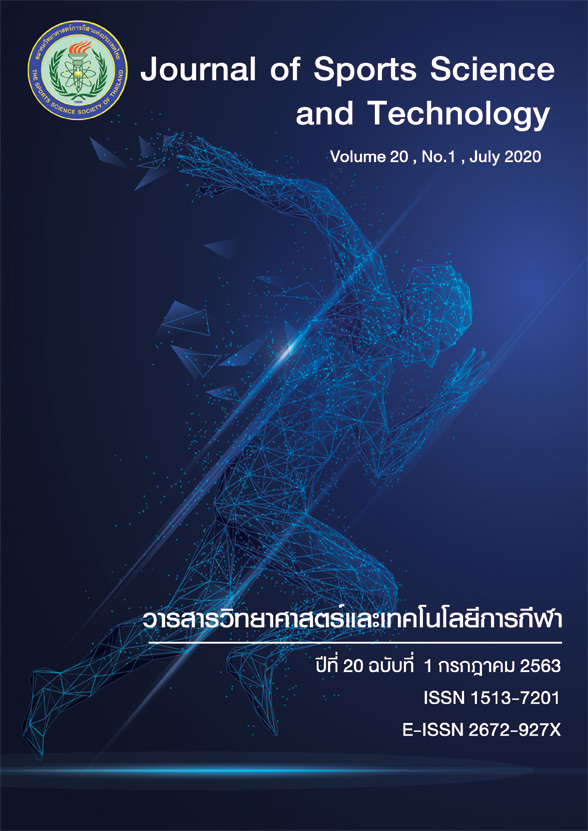COMPARISON OF MOVEMENT PATTERNS AND MOTIVATION LEVEL WHILE PLAYING ACTIVE VIDEOGAMES IN CHILDREN WITH CHRONIC ANKLE INSTABILITY
DOI:
https://doi.org/10.14456/jsst.2020.1Keywords:
Active videogame, Children/ Chronic Ankle Instability/ Motivation/ Movement patternAbstract
Active video games (AVGs) are accepted as enjoyable exercising tools for rehabilitation. It offers a potential solution to improve adherence by increasing motivation levels in patients who require long-term rehabilitation sessions such as those with chronic ankle instability (CAI). The prevalence of CAI is high in children, but no evidences reporting movement patterns while playing AVGs in children. Therefore, this study aimed to compare movement patterns and intrinsic motivation levels while playing AVGs between children with CAI and typical children. Thirty children aged between 8 and 14 years old were recruited. They were divided into two groups including children with CAI (n=15) and typical children (n=15). Each child performed 4 AVGs including running, dancing, catching fish, and Russian block for 5 minutes per game. Percentage of movement patterns and intrinsic motivation levels were measured. The results revealed that there were no significant differences (p>0.05) between groups except the percentage of double leg stance (DLS) while playing catching fish (p<0.05). In addition, there was significant difference between groups for perceived competence in Russian block; effort/importance in catching fish; and value/usefulness in dancing (p<0.05). In conclusion, this study showed similar movement patterns among the 4 AVGs in both groups. However, the findings suggested that catching fish, dancing, and Russian block showed greater movement patterns than running including single leg stance, double leg stance and reaching direction. In addition, this study found that dancing could cause higher pressure to the players than comparing with others. Therefore, catching fish and Russian block may help to encourage the single leg standing patterns of children with CAI. These game are inexpensive tool, high motivation level and simply to apply both in clinic and home. Further studies are highly recommended to investigate the effectiveness of the AVGs for improving common deficits in children with CAI.
(Journal of Sports Science and Technology 2020; 20(1): 7-19) (Received: 4 December 2019, Revised: 12 April 2020, Accepted: 13 April 2020) Keywords: Active videogame, Children/ Chronic Ankle Instability/ Motivation/ Movement pattern
*Corresponding Author: Raweewan LEKSKULCHAI
Faculty of Physical Therapy, Mahidol University, Nakhon Pathom, THAILAND 73170
E-mail: raweewan.lek@mahidol.ac.th
References
2. Mandarakas M, Pourkazemi F, Sman A, Burns J, Hiller CE. Systematic review of chronic ankle instability in children. J Foot Ankle Res 2014; 7(1): 1-10.
3. Hiller CE, Refshauge KM, Herbert RD, Kilbreath SL. Intrinsic predictors of lateral ankle sprain in adolescent dancers: a prospective cohort study. Clin J Sport Med. 2008; 18: 44-8.
4. Hale SA, Hertel J, Olmsted-Kramer LC. The effect of a 4-week comprehensive rehabilitation program on postural control and lower extremity function in individuals with chronic ankle instability. J Orthop Sports Phys Ther. 2007; 37(6): 303-11.
5. Mattacola CG, Dwyer MK. Rehabilitation of the ankle after acute sprain or chronic instability. J Athl Train. 2002; 37(4): 413-29.
6. Fitzgerald D, Trakarnratanakul N, Smyth B, Caulfield B. Effects of a wobble board-based therapeutic exergaming system for balance training on dynamic postural stability and intrinsic motivation levels. J Orthop Sports Phys Ther. 2010; 40(1): 11-9.
7. Mentiplay BF, FitzGerald TL, Clark RA, Bower KJ, Denehy L, Spittle AJ. Do video game interventions improve motor outcomes in children with developmental coordination disorder? A systematic review using the ICF framework. BMC Pediatr. 2019; 19: 22; 1-15.
8. Staiano AE and Flynn R. Therapeutic Uses of Active Videogames: A Systematic Review. Games Health J. 2014; 3(6): 351-65.
9. Beynnon BD, Murphy DF, and Alosa DM. Predictive Factors for Lateral Ankle Sprains: A Literature Review. J Athl Train. 2002; 37(4): 376-80.
10. Rein S, Fabian T, Zwipp H, Mittag-Bonsch M, Weindel S. Influence of age, body mass index and leg dominance on functional ankle stability. Foot Ankle Int. 2010; 31(5): 423-32.
11. Chen H, Li HY, Zhang J, Hua YH, Chen SY. Difference in postural control between patients with functional and mechanical ankle instability. Foot Ankle Int. 2014; 35(10): 1068-74.
12. Deci EL, Koestner R, Ryan RM. A meta-analytic review of experiments examining the effects of extrinsic rewards on intrinsic motivation. Psychol Bull. 1999: 125: 627- 68.






